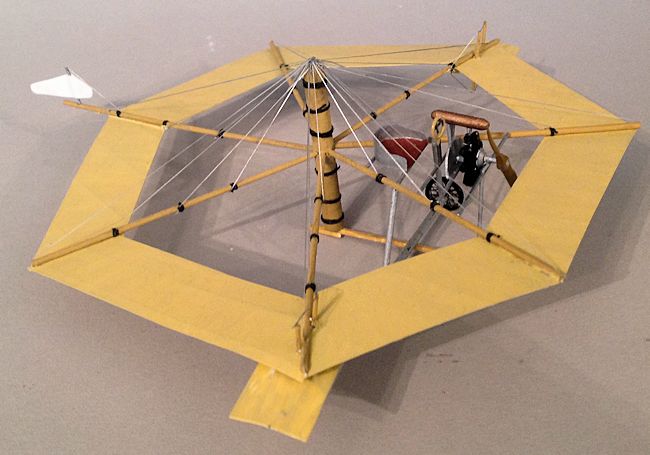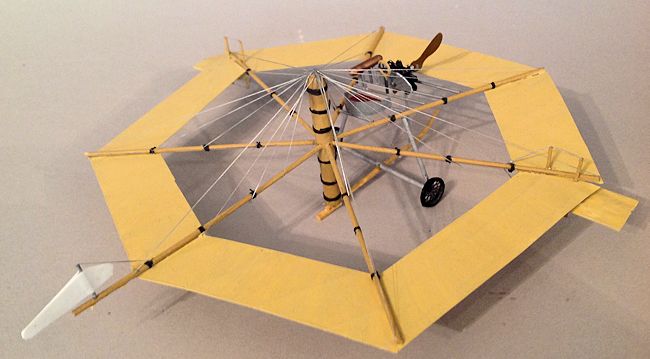
| KIT #: | ? |
| PRICE: | $ |
| DECALS: | None |
| REVIEWER: | Chris Peachment |
| NOTES: | Made from plastic and wooden rod and strut, with some 10 thou plastic card |

| HISTORY |
In July, 1911, aeronautical engineer
and designer William Romme made two short flights in his most famous design the
Umbrellaplane, or Cycloplane as it was sometimes called. At least seven
different configurations of it are known
Harold McCormick, of the harvesting machine
manufacturing business, and millionaire John D. Rockefeller supported the
design. In 1910 Romme had won a design contest with a circular model monoplane.
It was this that Romme developed into a full-scale airplane and bypassed the
Wright patents on their aircraft. McCormick and Rockefeller formed a corporation
to exploit the Romme designs.
The first monoplane was wrecked by gales in
November 1910. In April 1911 it was given some preliminary testing in San
Antonio, Texas. While taxiing, it struck a rut, was turned over by the wind and
badly damaged. Romme escaped without injury.
 After
this, no further progress was made, because of the wait for a Gnome engine.
After
this, no further progress was made, because of the wait for a Gnome engine.
At the same time McCormick hired another
engineer, from the University of Pennsylvania, Chance Milton Vought. He guided
the development of the Umbrella Plane through its career. By July 15, 1911, the
two McCormick airplanes had their Gnome engines installed, and on August
23,1911, Romme made the first successful flight reaching a height of 15 feet.
Movable control surfaces were installed on
each side at the rear of the circular wing, rudders with greater cord replaced
the two tall narrow rudders, and triangular centre projections on the wing were
removed.
In early 1912, the propeller was attached
directly to the Gnome engine eliminating the long drive shaft, ribs were
installed in some of the wing surfaces, ailerons were moved forward, the rudder
was moved further aft, and the separate elevator was eliminated and replaced by
warping the wing trailing edge.
In April 1912, Andre Ruez, McCormick’s test
pilot gave the Gnome engine full throttle and lifted the aircraft off the ground
in a short hop. During the next few days Ruel climbed higher and made longer
flights until he reached a height of 30 feet. Several minor changes were made
and flights continued in 1912. In
March 1913, Max Lillie made several circuits of the Cicero field, in the
Umbrella Plane, which attracted an immense interest from spectators.
It was finally abandoned in 1913.
Vought, in a newspaper interview, said that the umbrella plane was a
“freak” and an “oddball”.
| CONSTRUCTION |

It is worth noting that there were continuous
changes to the aircraft's layout, so it is worth deciding which one you want
from the photos.
The centre post was the first thing to start
with, and since I didn't have any plastic rod of that width, I chose an old
paint brush and sawed off the end of the handle. Bevel the ends with a file and
sandpaper. Now comes the only hard
part.
It has seven radiating spokes, and so you must
sit down with your geometry set, suck your pen and work out how 360 degrees
divides by seven, then mark where each spoke is mounted on the centre post.
Drill out each mounting hole with a drill of the appropriate size, cut lengths
of plastic rod to length, noting that the rear one for the rudder is longer than
the others, then mount each spoke into its hole with superglue. I notice that “Buffirn”
on the Reader's Forum of this website has discovered the delights of superglue
gel. It is much more controllable than the runny stuff, and has the bonus of not
glueing your fingers together. I never use anything else.
 You can
now sit back with a soothing drink and note how none of the spokes look at all
regular. Curse Euclid for a bit, then start bending the spokes at their base
until they look regular. You can take consolation in the fact that this is
probably how the original was constructed.
You can
now sit back with a soothing drink and note how none of the spokes look at all
regular. Curse Euclid for a bit, then start bending the spokes at their base
until they look regular. You can take consolation in the fact that this is
probably how the original was constructed.
Note that the spokes and central post seem to
have been bound in what looks like cord. I have a feeling they might have been
bamboo, which has a very high compressive and tensile strength, but weaker
flexural strength and so the fibres often need this kind of strengthening. For
this I used black thread and superglue.
Anyone who has made fishing flies will find it no trouble. Anyone else is
going to need a magnifying glasses and a steady hand.
Each wing was cut from 10 thou card. In the
original they were supported by loose ribs which were sewn into pockets on the
underside. I scored the undersides with a metal rule and a couple of passes of a
black biro to reproduce this. Otherwise it was all a loose affair, and can be
seen flapping around in the breeze, so don't worry too much about wing rigidity
here.
Make a small rudder from two bits of 10 thou
card cut to pattern and sandwich a vertical rod in between them.
| COLORS & MARKINGS |
It is best done now. The wing linen got a coat
of Vallejo Buff, and the wood bits got a coat of dark yellow. I did the rudder
in white just for a little variation.
Some rods of varying length were introduced at
the forward end, between two spokes, and painted silver. The engine backing
plate is mounted on one of them, carrying the rotary engine, and small support
for the prop shaft is mounted on the forward rod. A seat was made up of sheet
plastic, silver with a leather cushion formed from filler. The control column
was made from rod, surmounted with a
wheel of solder with flat spokes. And four short posts from rod support
the fuel tank which is a length of sprue with rounded ends. Paint it bronze.
Two ailerons, or balancers as they were called
then, were made from card, supported by two rods each drilled through the centre
line. Incidentally, I can see no reason why ailerons didn't stay in the language
 as
“balancer”, a term far more descriptive than aileron, which is simply French for
a small wing. But then we derive most of our military terms from French.
as
“balancer”, a term far more descriptive than aileron, which is simply French for
a small wing. But then we derive most of our military terms from French.
Cadre, platoon,
infantry, corps, cavalry, squadron, reconnaissance, morale, esprit de corps,
aide de camp, Captain, Colonel, General, Admiral, all are French in origin. I
suspect the influence of Napoleon here. He seems to have been the fount of all
things dangerous in the modern world.
Rigging is straightforward, from the top of
the central king post out to the places where the spokes are bound. I used my
usual method of elastic thread, coloured silver with a gel pen, and glued down
with gel superglue, placed by a sharpened toothpick. The aileron actuator rods
will need rigging too. Also a line to the rudder post.
The undercarriage too is straightforward. A
curved skid was made from 20 thou card, supported at the rear end on the bottom
of the king post, with supporting struts up front from rod. Spoked wheels came
from Eduard etched sets of WWI, which are invaluable when modelling pioneer
aircraft. Tyres were solder wrapped
around a paint brush handle of the right diameter. A rear skid was added to the
curved skid, just below the king post. Finally
a prop from the Bag of Dead Props, painted wood brown, with dark brown grain,
and coat of clear orange, was mounted at ten to four.
| CONCLUSIONS |
 There
you have it, another aircraft which no man of sound body and sane mind would
climb onto. It did nonetheless take to the air, and managed extended circuits
around the airfield, before being abandoned as a bad idea. But it did have its
later influence. The engineer Charles Vought died in 1930, but the Chance Vought
company went on to create the
Flying Pancake circular wing aircraft.
With such forbears it must have been more than just vague memory of the
Umbrellaplane which inspired them. Perhaps aircraft are Buddhist machines and
undergo reincarnation.
There
you have it, another aircraft which no man of sound body and sane mind would
climb onto. It did nonetheless take to the air, and managed extended circuits
around the airfield, before being abandoned as a bad idea. But it did have its
later influence. The engineer Charles Vought died in 1930, but the Chance Vought
company went on to create the
Flying Pancake circular wing aircraft.
With such forbears it must have been more than just vague memory of the
Umbrellaplane which inspired them. Perhaps aircraft are Buddhist machines and
undergo reincarnation.
| REFERENCES |
http://celticowboy.com/Early%20Acft%20Photo.htm
http://www.lincolnbeachey.com/cicart.html
October 2014
If you would like your product reviewed fairly and fairly quickly, please contact the editor or see other details in the Note to Contributors.